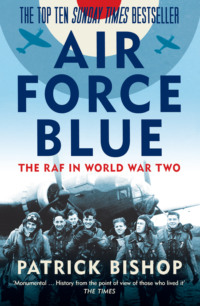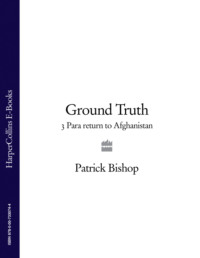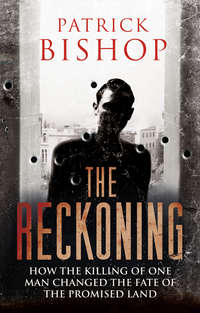
Bomber Boys: Fighting Back 1940–1945
The road to the operational squadrons was long and expensive. It cost on average £10,000 to train each crew member, the equivalent, according to one indicator, of about £850,000 in today’s money. This was a lot to pay to get each Bomber Boy into battle. It did not, however, mean that when they got there, their lives would be worth very much.
5 Dying in the Dark
Bomber Command lost 4,823 men and 2,331 aircraft on operations in the first two years of the war. There was very little to show for it. In that time it dropped only 35,194 tons of bombs. That was two thousand tons less than it dropped in the single month of May, 1944. Despite the great effort, the resulting destruction was often small and the casualties inflicted were minimal. A typical night’s work was that of 29/30 August 1941. More than 140 aircraft were sent to attack railways and harbours in Frankfurt. They reached their target successfully and began bombing. They managed to do some damage to a gasworks, a barrel warehouse and a few houses and to kill eight people. In the course of the operation one Hampden was lost without trace. Another crashed in France killing all on board. A Halifax crew baled out over England after running out of fuel but two men died in the process, one after his parachute got caught in the tailplane. A Whitley was forced to ditch off the Essex coast. All in all, the operation resulted in the loss of sixteen lives – two for every German killed – and seven aircraft. Despite the sacrifice, the attack barely bothered the Frankfurt authorities who nonchalantly recorded the raid as ‘light and scattered bombing’.
The perils of each trip mounted as the German fighter and flak defences adapted and improved. In March 1941, Doug Mourton arrived at 102 Squadron to fly as a wireless operator on Whitleys. One night his crew were detailed to attack Hamburg. Initially, it seemed ‘a comparatively easy trip’. They took off in bright moonlight and as the target approached Mourton could see another Whitley flying a parallel course. ‘Suddenly it exploded. What had been an aircraft a few seconds before, was now a mass of debris, flying through the air. It had apparently been hit by an anti-aircraft shell, most likely in its bomb bay …’ He learned later that the pilot had been Alec Elliot, his best friend on the squadron with whom he had passed many nights in the pub and played innumerable games of crib while waiting in the crew room.1
After enduring such experiences the crews were reluctant to believe that their efforts were being wasted. To be able to carry on it was necessary to persuade oneself that the risks were worth it. From the air it was impossible to know whether or not a raid had succeeded. The sight of big fires burning below was taken as a measure of success. But they could not know what these blazes were. The Germans soon suspected that the attacking aircraft had often only the haziest idea of their whereabouts. They developed a system of decoy fires which they hoped the arriving aircraft would mistake for the target. It worked very well. Many a crew returned home satisfied they had carried out their mission after bombing empty countryside.
A different sort of deception was being perpetrated on the home front. Government propaganda painted a picture of continuous success. A broadcast by Flight Lieutenant J. C. Mackintosh, a bomb-aimer in a Hampden, made night bombing sound like a cool, precise science. His script started with the bold assertion that ‘when the war began we were well-trained in finding targets in the dark and were therefore never compelled to bomb indiscriminately through the clouds.’ He went on to describe a recent attack on an oil refinery. At first, the crew thought it a tricky target. But the fact that it was sited near a bend on a river which would provide a useful navigational reference caused them to decide that ‘perhaps, after all, it would not be such a difficult job to find.’ As they entered the target area they located the river but after three runs through anti-aircraft fire had still not spotted the objective. Mackintosh gamely called on the skipper to go round once more. Then, ‘there it was. The dim outline of an oil refinery wonderfully camouflaged. It was getting more and more into the centre of the sights. I pressed the button and my stick of bombs went hurtling towards Germany’s precious oil. The rear gunner watched the bombs burst and in a very few seconds those thousands of tons of valuable oil had become hundreds of feet of black and acrid smoke.’2
This was strategic bombing as dreamt of by the Air Ministry planners. But it was rare indeed that events followed Mackintosh’s script. A more typical experience was that of Eric Woods, who had joined the RAF before the war as a reservist and qualified as a navigator before being sent to 144 Squadron. His first operation was on the night of 9/10 October 1940 and the target was the Krupp factory in Essen, one of the first of many that would be launched against this citadel of German military industry. At the briefing the crews were told they could expect only scattered cloud over the target. But ‘from the outset it was obvious that the Met people had got it wrong as a solid mass of cloud was clearly visible below and as we progressed eastwards we saw that the cloud was becoming denser ahead. We pressed on but two ominous developments took place: a film of ice appeared on the windscreen and an opaque mass of rime ice began to spread out along the leading edge of each wing.’ His Hampden’s twin engines started to run rough as ice found its way into the fuel inlet system. ‘There was a hurried conference since it was pretty obvious that the target was unlikely to be identifiable, so the decision was taken to fly on and see what happened when we reached our ETA (Estimated Time of Arrival). In the event at that time we were still in dense cloud, the whole mass being lit up by searchlights sweeping below, with frequent bright flashes which could have been anti-aircraft fire or bomb bursts, I certainly knew not what.’ With no sight of the ground and dreadful weather conditions a decision was made not to bomb but to seek some alternative target on the way home. As they headed homewards ‘the cloud began to break up to the west, quite the opposite to what the weatherman had said … we did in fact fly along the Scheldt estuary and as we passed over the port of Flushing the navigator let go with our total load and I clearly saw bomb bursts though I wasn’t sure precisely where they landed.’3 Only three of the aircraft that set out reached their target.
The basic problem remained navigation. There was no accurate means of directing the bombers to faraway targets and none would arrive until March 1942. In the meantime, navigators relied on dead reckoning and the main instrumental aid was the sextant. This was still the pioneer age of bombing. ‘The aircraft were without heating and the cold was appalling,’ wrote Doug Mourton later. ‘The crews flew clothed in layers of silk, wool and leather and yet they were still bitterly cold. Vital systems jammed, wings iced up for lack of adequate de-icing gear [and] guns froze …’ The navigator gave his pilot a course on take-off and then, if he was lucky and the skies were clear, looked out for landmarks to check if they were on track. When visiting Germany they left England’s shores over Flamborough Head then scoured the sea below for the Friesian Islands off the Dutch coast, where German night-fighters lurked, straining to get at the raiders. If the conditions were right, the navigator might use his sextant to obtain a fix from the stars, but only if the pilot was willing to fly straight and level long enough. The crews were given a weather forecast before leaving, but they were notoriously unreliable. Predicted winds failed to blow and unpredicted ones drove the bombers hopelessly off course. It was no wonder that German targets were sometimes unaware that they had been the subject of an attempted attack.
The gap between what was expected of the RAF and what it could in fact deliver was enormous. The man whose task it was to narrow it was Charles Portal, appointed to the top air force post of Chief of the Air Staff (CAS) in October 1940 at the young age of forty-seven. The promotion came after a brief, six-month stint as the Commander-in-Chief of Bomber Command. He was to stay in his post for the rest of the war. Portal was short and stocky, with a lean, creased face, hooded eyes and a large, hooked nose which gave him the look of one of the falcons he had reared when a schoolboy at Winchester. He was at Christ Church, Oxford, when the war broke out in 1914, and immediately suspended his studies to go to France as a motorcyclist with the Royal Engineers. In 1915 he joined the Royal Flying Corps and finished the war as a lieutenant-colonel. His intellectual gifts and boundless capacity for work ensured that his subsequent climb was sure and fast. His character and demeanour contrasted sharply with that of Arthur Harris. He hid his feelings behind a mask of scrupulous courtesy and expressed himself quietly and subtly. Whereas Harris was capable of rough bonhomie, Portal never unbent. Those around him noticed that beyond his family he had no close friends, gently repelling company when he dined at the Travellers’ Club at the end of his long working day.
Portal’s part in the policy of attacking whole cities, ‘area bombing’ in the bureaucratic euphemism of the day, is little known or remembered nowadays, while Harris’s name will be linked to it for ever. But his enthusiasm for the project was, at the outset at least, just as great as that of his subordinate and he was prepared to express himself forcefully in support of it even when Churchill’s faith faltered.
As head of Bomber Command at the start of the Blitz he sympathized with the public desire for revenge and had joined Churchill in urging reprisals on a reluctant Air Staff. On arriving at the top, he stressed the need to destroy the resolve of the German people by smashing their towns and cities. The rhythms of Bomber Command’s activities would vary from time to time as it was diverted to deal with various threats and crises. But, until the run-up to D-Day, this was to be the central theme of the air war.
In successive directives Portal continued to point his men towards industrial and military targets. But great emphasis was given to the will-sapping potential that he claimed would result. On 30 October 1940, as London prepared to endure its 53rd night of continuous bombardment, he wrote to Sir Richard Peirse who had replaced him as C-in-C, Bomber Command, that
the time seems particularly opportune to make a definite attempt with our offensive to affect the morale of the German people when they can no longer expect an early victory and are faced with the near approach of winter and the certainty of a long war … if bombing is to have its full moral effect, it must on occasions produce heavy material destruction. Widespread light attacks are more likely to produce contempt for bombing than fear of it. I am therefore directed to say that as an alternative to attacks designed for material destruction against our primary objectives, it is desired that regular concentrated attacks shall be made on objectives in large towns and centres of industry with the prime aim of causing heavy material destruction, which will demonstrate to the enemy the power and severity of air bombardment and the hardship and dislocation that will result from it.
Berlin was put first on the list for Bomber Command’s attentions. If it was clouded over, other towns in central and western Germany were to be considered. Aircraft industry and oil targets might also be selected, as long as they were ‘suitably placed in the centres of the towns or populated districts’. The directive envisaged sending greater numbers of aircraft, carrying a mix of bombs. The first to arrive would drop incendiaries to set the target area ablaze. The following force would then ‘focus their attacks to a large extent on the fires with a view to preventing the fire-fighting services dealing with them and giving the fires every opportunity to spread.’4 This amounted to an explicit announcement that the strategic aim now was to achieve blanket destruction, disruption and death.
In reality, Bomber Command lacked the resources to carry out such an apocalyptic plan. Even if it had the aircraft and equipment, it would never be able to mount a concentrated and relentless campaign while it was subject to the apparently insatiable calls on its services from the War Cabinet, navy and army.
On top of the strategic targets, oil and now cities, Bomber Command was supposed to support the navy by laying mines at sea. In March 1941 another great responsibility was loaded on to its shoulders. German submarines and bombers were wreaking terrible damage on the transatlantic convoys carrying the cargoes that kept Britain alive and threatening to sever Britain’s vital ocean links with America. Churchill ordered Portal to concentrate on attacking the yards that built the U-boats and the pens where they sheltered, as well as the factories and bases which produced and housed the maritime bombers. Bomber Command did its best against these targets, and the great German warships Gneisenau and Scharnhorst in their haven at Brest, but the effects were limited. Its aircraft were withdrawn after four months and it was left to Coastal Command and the Royal Navy, aided by improvements in technology and resources, to turn the Battle of the Atlantic Britain’s way.
The diversion deflected Peirse from his intention to use the improved conditions of spring to systematically pursue oil targets. The ‘oil plan’ had many powerful supporters inside the Air Staff and among civilian specialist strategic advisers. They saw the destruction of synthetic oil plants, which transformed Germany’s rich coal reserves into liquid fuels and lubricants, as a quick way of bringing the enemy to its knees. The plan would swing in and out of favour throughout the war. But the prescription was easier than the practice. Despite the claims of official propaganda, when oil targets were attacked, the results were often miserable. The plants were sited away from the big towns and were hard to find and even harder to destroy or damage. If the bombers missed them, as they usually did, their bombs hit nothing but fields and forests. The new practice of using high-flying Spitfires for photo reconnaissance the morning after a raid allowed an operation’s success to be assessed scientifically rather than relying on the visual reports and blurry night-time images submitted by the crews from onboard cameras. In the absence of hard evidence, optimism about the progress of the campaign had remained high in the upper reaches of the RAF. The daylight pictures showed it to be misplaced. No assumptions could be made about bombing accuracy. The truth, according to Sir John Slessor, who had taken over 5 Group of Bomber Command in May 1941, was that the crews were ‘failing to find and hit any but the most obvious targets on the clearest moonlight nights’.5
It became clear to Portal that, as things stood, the only target that Bomber Command could be guaranteed to find was a largish town. The attacks on London, Coventry, Southampton, Plymouth and elsewhere had provided more than enough justification for retaliating in kind. Britain had suffered an unprecedented loss of innocent life. By the time the Blitz petered out in May 1941, more than 41,000 civilians had been killed and 137,000 injured. Such a policy, Portal now believed, was not simply faute de mieux, but a logical and desirable course of action.
The new, or rather resumed, thinking was spelled out in another Portal directive to Bomber Command dated 9 July 1941. It stated that a comprehensive review of Germany’s political, economic and military situation disclosed that one of ‘the weakest points in his armour’ lay in the morale of the civilian population. It called for ‘heavy, concentrated and continuous area attacks of large working-class and industrial areas in carefully selected towns’. At the end of August the formula was extended to smaller towns so that they too could experience ‘the direct effect of our offensive’.6
This marked another important step in the shift from scrupulousness to ruthlessness. Before the war the British government had assured the world it had no intention of bombing civilians. Now the RAF had been nudged on to a heading which made the mass killing of civilians inevitable. The faith that was put in the belief that this would produce beneficial results by undermining the Germans’ will to fight on was puzzling. Nothing that had happened in the war to date supported Trenchard’s dictum that the moral effect of bombing was twenty times greater than the material effect. If anything, the experience of Coventry, London and other blitzed towns like Plymouth and Liverpool, suggested the opposite. Yet in the absence of any immediate alternative, what was an ill-founded opinion began to take on the solidity of an iron law of war.
Trenchard was an old man now but he was still regarded with reverence by the military establishment and his views were treated with respect. In May 1941 he sent a memorandum on the current state of the air war to the Chiefs of Staff. He reduced the complexities of the problems facing the RAF to one simple proposition. It was, he reiterated, all a question of national morale and who could stand their losses best. There was no doubt about the answer. For Trenchard, the ‘outstanding fact’ of the current situation was ‘the ingrained morale of the British nation which is nowhere more strongly manifest than in its ability to stand up to losses and its power to bear the whole strain of war and its casualties.’ History had proved ‘that we have always been able to stand our casualties better than other Nations.’ As for the enemy, ‘all the evidence of the last war and of this, shows that the German nation is peculiarly susceptible to air bombing. While the A.R.P. services are probably organized with typical German efficiency, their total disregard to the well-being of the population tends to a dislocation of ordinary life which has its inevitable reaction on civilian morale. The ordinary people are neither allowed, nor offer, to play their part in rescue or restoration work; virtually imprisoned in their shelters or within the bombed area, they remain passive and easy prey to hysteria and panic without anything to mitigate the inevitable confusion and chaos. There is no joking in the German shelters as in ours, nor the bond which unites the public with A.R.P. and Military services here of all working together in a common cause to defeat the attacks of the enemy.’ This, he concluded ‘is their weak point compared with ourselves and it is at this weak point that we should strike and strike again.’ Such a policy would mean ‘fairly heavy casualties’ for those doing the bombing, but Trenchard had faith in their toughness. In his judgement, ‘the pilots in the last war stood it, and the pilots in this war are even better and, I feel, would welcome a policy of this description.’7
Where Trenchard got his information from was a mystery. At least one pilot had a very different appreciation of the morale question. In the early winter of 1942 when Bomber Command was beginning to bring the war to the German people Guy Gibson was still unconvinced that domestic morale would collapse. ‘We are dealing with the mass pyschology of a nation and a bad nation at that,’ he told Charles Martin, the adjutant of 106 Squadron. ‘It is run, organized and controlled by Gestapo and SS Police … the fact still remains that if they were to give in they would have everything to lose and nothing to gain. I think myself they will fight to the end.’ Gibson had little time for ‘people who go around talking so much bull about the crack appearing and once the crack has appeared the foundation will weaken etc., etc.’8
Most people who were running the war agreed with Trenchard. It would have seemed defeatist to say otherwise. Identifying morale as the main target also provided some hope of progress at a time when there was little to show that Bomber Command was achieving anything. Any scrap of evidence was seized on as proof of the wisdom of this course. In September 1941 the American correspondent William Shirer who knew Nazi Germany well, wrote a piece in the Daily Telegraph saying that attacking war industries was not enough. ‘What [the RAF] must do is to keep the German people in their damp, cold cellars at night, prevent them from sleeping and wear down their nerves. Those nerves are already very thin after seven years of belt-tightening Nazi mobilization for total war. The British should do this every night.’ The cutting was reverently placed in an Air Ministry file. The Ministry of Information maintained its own survey. It had concluded as early as December 1940 that ‘the Germans, for all their present confidence and cockiness will not stand a quarter of the bombing that the British have shown they can take.’
In the middle of 1941 support for the bombing offensive was sustained by faith rather than evidence, but the absence of a rational foundation for belief meant only that the flame of conviction burned all the brighter. It was not only Portal and the Air Staff who believed. The heads of the navy and the army became fervent converts. At the end of July 1941 they had produced a statement on general British strategy in which they declared their support for Bomber Command’s mission and admitted they were relying on an all-out attack by the RAF to create the conditions for a land invasion and victory. Inter-service jealousy over resources, hitherto a genetic condition, was forgotten as the air force was offered everything it wanted.
They approved the building of heavy bombers as a first priority ‘for only the heavy bomber can produce the conditions under which other offensive force can be employed.’ They endorsed the view that the focus of attack should be ‘on civilian morale with the intensity and continuity which are essential if a final breakdown is to be produced.’ If the plan was pursued ‘on a vast scale, the whole structure upon which the German forces are based, the economic system, the machinery for production and destruction, the morale of the nation will be destroyed.’ This was just the ‘bull about the crack appearing’ that Gibson had found so unconvincing.
Soon afterwards an attempt was made to translate what were instinctive suppositions into hard formulae. In September 1941 the Directorate of Bomber Operations at the Air Ministry began working on a new plan. In an important departure from previous practice it was based not on what Bomber Command might do, but on what the Luftwaffe had already done. By analysing the damage caused by German air attacks on London, Coventry, and other English towns, the planners came up with a yardstick of what was needed to mount an all-out offensive on German towns.
They used an ‘index of activity’ to gauge the effects of bombing on a town’s ability to function. Coventry, it was reckoned, had suffered a 63 per cent reduction in its index of activity the morning after the raid. The calculation included not just physical destruction but also psychological damage; fear and demoralization. It had taken Coventry thirty-five days to recover. Four or five follow-up attacks on the same scale, it was reckoned, would have crippled the city’s ability to operate. A sixth raid would have put it ‘beyond all hope of recovery’.
Using the same encouraging extrapolations that were always employed with such calculations, it concluded that if 4,000 bombers were directed against forty-three towns with populations of 100,000 or more, Germany would be finished. At the time, the average daily availability of bombers was just over 500. Portal approved the plan and passed it on to the prime minister promising ‘decisive results’ in six months if he was given the aircraft required.
But Churchill’s initial enthusiasm was faltering. A minute study of reconnaissance photographs ordered by Churchill’s scientific adviser Lord Cherwell had revealed in undeniable detail the blindness of the bombing effort. The work was carried out by D. R. Butt, a civil servant with the Cabinet secretariat. His job was to analyse photographs taken on one hundred night attacks during June and July 1941. The results, published in August 1941, were dismaying. The essential finding was that of those crews claiming to have attacked a target in Germany, only one in four got within five miles of it. Over the Ruhr the proportion was one in ten. The statistics related only to aircraft recorded as attacking the target. One third of the crews failed to get within five miles of it.









